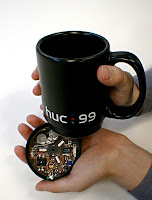I was invited to Leipzig to talk about social networks and in the context of insurance companies (http://www.versicherungsforen.net/social-media). The main focus of the talk was to show what people currently do in social networks and to speculate why they do it (and I used a picture of the seven deadly sins as an illustrations…) Additionally I discussed some prototypes of activity recognition and their potential once integrated into social media.
My talk was entitled “500 Freunde (auf Facebook): Wozu noch eine Versicherung?“ – „500 friends (on Facebook) – Is there still need for insurance?“ and discussed how ubiquitous capture and social media may shape the next community [1]. The slides in are in German.
The event was very interesting and I would expect that there is a great potential out there for insurance companies to tap into. Looking back at the original idea of insurance (e.g. old fire insurance communities) or sharing the risk of hail in farming communities can give interesting inspiration for peer-2-peer insurance models. It will be exciting to see if there a new products and services that come out of the “big players” or if new players will come to the game. To me the central issue to address is how to make insurance products more visible – and I think a user centered design approach could be very interesting…
In the future I would expect that finding the right value mix (privacy, price, safety, etc.) will be essential as we argued for other services in [2]. Some years back we wrote in an article about RFID [3] “privacy is sacred but cheap” and the more services we see the more I am convinced that this is more than a slogan. If you can create a service that is of immediate value to the user I would I expect that privacy will be a lesser concern to most? On the other hand if you reduce privacy without any value in exchange there is always an outcry…
[1] “500 Freunde (auf Facebook): Wozu noch eine Versicherung?“ – Ermöglichen allgegenwärtige Aufzeichnungs-technologien und digitale soziale Netze die nächste Solidargemeinschaft? Slides as PDF (in German)
[2] Albrecht Schmidt, Marc Langheinrich, Kristian Kersting, “Perception beyond the Here and Now,” Computer, vol. 44, no. 2, pp. 86-88, Feb. 2011, doi:10.1109/MC.2011.54 (final version at IEEE, free draft version)
[3] Schmidt, A.; Spiekermann, S.; Gershman, A.; Michahelles, F., “Real-World Challenges of Pervasive Computing“, Pervasive Computing, IEEE , vol.5, no.3pp. 91- 93, c3, July-Sept. 2006. 10.1109/MPRV.2006.57

























